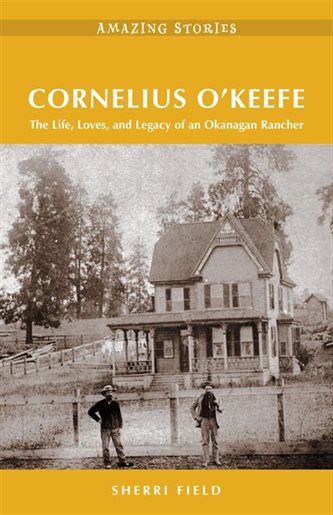
Cornelius O’Keefe: the Life, Loves, and Legacy of an Okanagan Rancher
Review By Duane Thomson
November 12, 2019
BC Studies no. 205 Spring 2020 | p. 120-121
Cornelius O’Keefe was one of a small group of pioneer Okanagan ranchers who managed, in the late nineteenth century, to accumulate land, wealth, and influence. His rags-to-riches story was made possible by a combination of timing, luck, vision, and good management. Unlike some others in the “cattle oligarchy” in the Okanagan, men such as Price Ellison and Forbes G. Vernon, he did not aspire to provincial or national political power but was content to accumulate land and wealth and to display it publicly.
Sherri Field first explores O’Keefe’s youth as the son of an illiterate, Irish-Catholic navvy who developed a subsistence farm in Fallowfield, ON. From age 14 to 24, Cornelius assisted his aged father in the myriad of heavy tasks of clearing dense timbered land, planting and harvesting grain and vegetables, and tending stock. In 1861, “Connie” left for the gold fields of British Columbia and in 1867 he formed a cattle partnership with Thomas Greenhow in the North Okanagan. O’Keefe quickly developed his home ranch, complete with a gristmill, general store, post office, and Catholic church. From a limited land base, but with free access to adjacent Crown grazing lands, O’Keefe and Greenhow gradually increased their herds to 400 head each by 1879. Their cattle found a lucrative market during the building of the transcontinental Canadian Pacific Railway in the early 1880s. With these revenues, the two cattlemen began to strategically acquire land, focussing on controlling access to water in the areas around Swan Lake and Priest’s Valley. As the market developed, O’Keefe turned to wheat farming, cultivating hundreds of acres in the Swan Lake area. When land values increased dramatically, O’Keefe and Greenhow’s widow sold out to land developers making the two families extremely wealthy by local standards.
Field uses a wide variety of sources to explore O’Keefe’s business operations and his personal life, from ranch and museum archives, census and land records, newspaper articles, artifacts found in the still-functioning ranch house, reminiscences of personal acquaintances, and family lore. She provides the date and legal description of each of O’Keefe’s land purchases, documenting his rise to land baron. These records might have been utilized more thoroughly. The land-assembly history of both O’Keefe and Greenhow would be much more understandable and impactful, even to a local audience, if she had included a detailed map of their holdings, illustrating the scope, timing, and strategy behind these purchases.
Field also explores the domestic and social aspects of O’Keefe’s life. She considers him to have been driven to improve his social standing. His ostentatious home and lavish parties, his presidency of the local jockey club, and his associations with the local elite demonstrated his need to achieve an elevated social position. In his role as employer, Field is more ambiguous, presenting him as a hard driving, intemperate, and miserly boss, but one who at times could be considerate, fair, and lenient.
She presents a brief history of his early Indigenous family as well as biographies of local, notable acquaintances, although the connections between O’Keefe and these men were not particularly close. O’Keefe’s social relationship with his business partner is not as thoroughly developed as it could be. The Oblate correspondence provides details about when O’Keefe’s young niece, Elizabeth Coughlan, decided to marry the older, protestant Thomas Greenhow. When O’Keefe refused his permission for the marriage, the two men became sworn enemies, a situation that lasted until Greenhow’s death in 1889. (PAC, Records of the Oblate Mission of British Columbia, Richard to d’Herbomez, letters written between 10 June 1879 and 19 June 1880.)
Field’s book is a good read, well organized and written. A few minor errors exist, however — O’Keefe’s partners Wood and Greenhow were from Newfoundland and England, respectively, Charles Houghton’s land grant and Thomas Wood’s pre-emption were not accurately located, and the Catholic bishop’s name was Durieu, not Durien. The use of proper titles and their capitalization is problematic, with titles such as the Chief Commissioner of Lands and Works and the Superintendent General of Indian Affairs mishandled.
Field’s biography of Cornelius O’Keefe is a welcome addition to the study of the one-generation cattle ranching era in the Okanagan, especially because his experience was representative in many ways. Like others in the “cattle oligopoly,” he benefitted from early entry to the industry, the ability to control access to water and exclude new entrants from the neighbourhood, free access to Crown grazing land for years, a good market for his cattle at a critical time, and ultimately dramatically increased land values.
Publication Information
Cornelius O’Keefe: the Life, Loves, and Legacy of an Okanagan Rancher. Sherri Field. Victoria: Heritage House, 2019. 149 pp. paperback.
